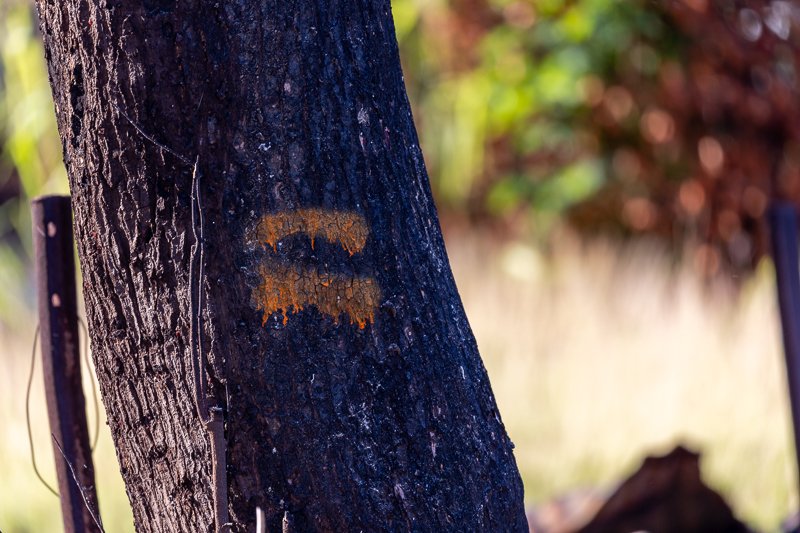Hazard Tree Assessments: A visual guide to the symbols on impacted trees
In the aftermath of unimaginable tragedy, trees can be symbols of strength, resilience, hope, and history. Sometimes, though the outside may be charred, the inside offers a glimpse of renewal. And, from the rubble of what once was, a small, green, fertile shoot delivers a promise of what will be once again.
The trees of Maui are no different. Yes, they are reminders of pain and disaster, but they are also proof of perseverance and promise for a beloved community and its people-past, present, and future.
Because of the significance of trees in the aftermath of the August 8 fires that ravaged Lahaina and Kula, arborists play a critical role in the U.S. Army Corps of Engineers (USACE)’s mission to complete Hazard Site Assessments in phase one of the debris removal process. Lahaina-based Kane’s Legacy Tree Services and Haiku-based Climbing HI are working under Hoʻōla Maui member DAWSON, the prime contractor for this phase of work, to carefully examine each tree to determine whether it might pose a potential hazard in the future. They are focusing on any tree that is at least four feet tall and six inches in diameter.
To determine a tree’s level of risk or resilience, arborist teams embark on a detailed and necessary process. It starts with identifying a tree’s species to understand its profile - growth habits, fire resistance, and ability to respond to stress. The teams then determine whether that tree poses a risk to infrastructure and look for indicators of whether that tree will be able to survive for the next four to five years. If a tree is still alive, the arborist teams assess the health of the tree by looking at its age; how much foliage it has; and the presence of decay, like hollowed areas, fungal organisms, pest infestations, root zone damage, broken limbs, and the injuries sustained by the fires.
Arborists and their teams are looking for indicators of distress as well as survival. For example, they look for keiki–the saplings at the base of the trees. With certain species, even when a mature tree cannot be saved, these young sprouts can grow and thrive–offering new life for the tree that was lost.
Whenever it is safe and possible to do so, arborists will work to preserve trees, especial those with cultural significance to the community, like ulu and koa. Cultural monitors are always part of the teams on site to help identify heritage trees that not only hold significant cultural value, but also the cultural sites that need to be protected from potential harm from damaged trees.
As teams walk through the community, they mark each tree with a colored symbol. Here is a look at the markings you may see on the trees and what they mean.
An orange “X” indicates that in the initial assessments done by EPA back in August and September, a tree was identified as posing an imminent hazard risk. Please avoid standing or parking near any trees marked with this symbol.
Example of a tree with an orange “X”, meaning that it poses a risk.
Stay away from trees with the orange “X” as they pose a risk.
An orange “=” indicates that a tree was identified as not posing an imminent threat or risk during the initial assessments done by EPA back in August and September. However, because conditions continue to change, it's possible that a tree may have become more of a hazard risk in recent months. Often, these trees will be also marked with a blue dot (see below) from a subsequent assessment.
Some trees with an orange “=” may also have a blue dot from a follow-up assessment.
Trees with an orange “=” were deemed safe by the EPA in August and September assessments.
Blue dots on a tree trunk mean that tree is unlikely to survive the next four to five years and should be removed to prevent it from falling and potentially harming people or property.
The blue dot means that the tree should be removed because it is unlikely to survive the next four to five years.
A blue or yellow flag indicates that cultural monitors have identified a tree as a culturally significant species or one that has other cultural importance. Examples of cultural importance could include the history of the tree itself or situations where a tree serves as a marker of cultural importance for the ground beneath or near it. Property owners can share this information with the archeology and cultural monitor teams when they fill out their Right of Entry (ROE) paperwork; click here to learn more about that part of the process.
The flags do not necessarily mean that the tree has been identified for removal or for preservation. Arborists will still need to determine if it will have to be removed based on whether it may pose a potential hazard to people or property in the future.
Blue and yellow flags mark culturally significant trees.
If a tree is unmarked and a property has already been assessed by the arborists, it means that tree is showing signs of resilience and is likely to recover and thrive and can remain safely in place.
You can check if the arborists have been to a property by looking to see if that checklist item has been signed off on the USACE sign out front or by searching your property online using USACE’s digital portal.






